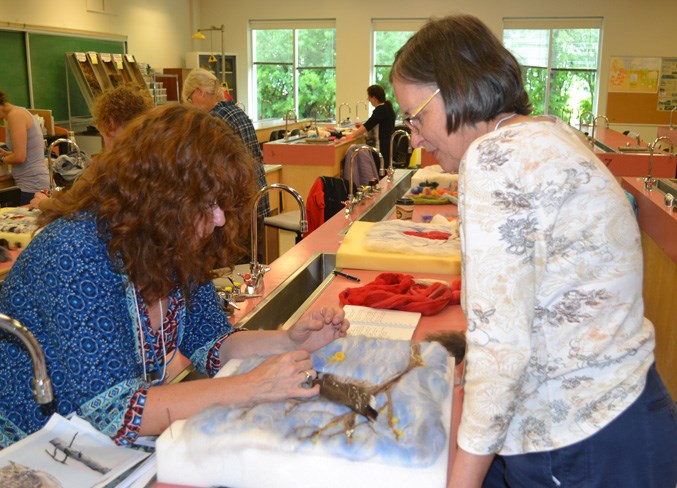They were working with wool and specially shaped needles. But instructor Lois McDonald-Layden says the students in her Felted Landscape and Birds class were not sculpting.
They were painting.
"I'm teaching them the process of needle felting and wet felting — that's using water — which is two types of felting; using those two methods to create a piece of wall art of their choosing," she said during an interview with the Albertan.
"They pick a picture and I show them the techniques required to make it into a piece of felted wall art. So it's really like painting with wool."
"It's a fibre course, but it's really an art course, right? We just have a different medium."
McDonald-Layden was speaking during a class she taught entitled Felted Landscape and Birds. About 16 people attended. It was one of several classes offered at Olds College during Fibre Week, which ran from July 5-11 this year.
Students in the Felted Landscape and Birds course came from across Canada and from the United States. McDonald-Layden herself is from New Brunswick. This is the third year she's taught felting at the college.
The students created their works in one day, from start to finish.
They utilized merino wool, which McDonald-Layden said is "a very common, fine wool that's readily available."
"It's dyed in all different colours and so you use it just like you would paint."
Artisans put the wool where they want with felting needles, which are special needles with barbs on them.
"It makes the wool adhere to itself. It makes it tangle together. So we use that like a paintbrush," McDonald-Layden said. "And then wet felting brings it all together, pulls it all together."
She said the process begins by laying down a base layer of fine wool.
Coarse wool is not used, for very good reason.
"It's not coarse, because if the first layer is coarse, it'll come through to the front," McDonald-Layden said. "When it felts, it all gets tangled, so if you use coarse on the bottom, it'll come through in the front and your painting will be — hairy. So you have to use pretty fine wool for the whole thing.
"And then you just lay down a layer of wool and then you start laying down your colours and making your details. And blend colours if you need to. We use embellishments too. We use silks and glitter; however you want your piece to look."
McDonald-Layden passed on one very important tip to her class.
She said they have to learn to "see with your eyes, not with your brain."
"Our brain doesn't see things accurately. Our brain fills in stuff. We don't see the colour properly," she said.
"So for instance, say there's a picture of a snowy hill at night. Our brain thinks because it's snow, it's white, so we'll start using white wool. But at night, snow is not white, snow is lavender or grey, right? So you need to see with your eyes.
"So like, we're doing birds here and a lot of people, when they're doing the outline of the bird, they're giving the birds a neck, because our brain thinks, you know, there's a head and a body and it needs a neck. But most birds don't have necks. If they look at the picture, there's no neck."
McDonald-Layden has been felting for eight years and as a full-time job for four years. She sells her work — including felted bird ornaments — all over the world.
"The bird ornaments are my full-time job. I do that like, 30, 40 hours a week. And then I make art and teach — when I can fit it in," she said.
One of McDonald-Layden's students, Jill Yelland DeMooy, came all the way from the Victoria area for the second year in a row. She believes she first learned about the course from "somebody in my guild."
She enjoyed the class and was working hard on creating a blue heron.



